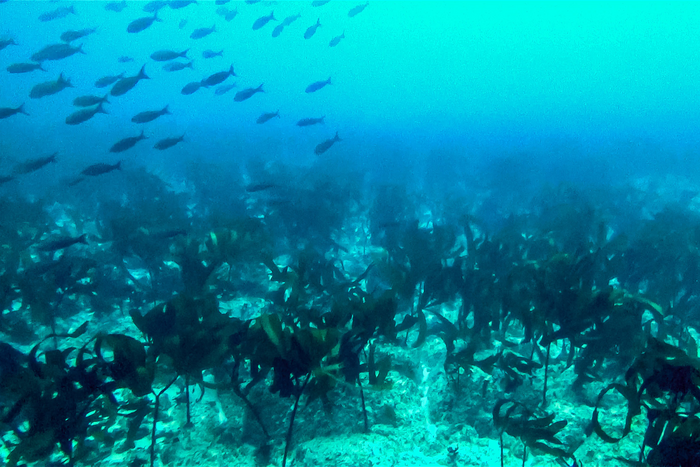A project (Seamounts Project) led by the Charles Darwin Foundation (CDF) found a vast kelp forest on the summit of a seamount at depths of ~50 m in the south of the Galapagos Islands. María Altamirano, a scientist at the University of Malaga’s Department of Botany and Plant Physiology, is a member of the scientific team that collaborated on the Seamounts Project.
 The significance of this research lies in a new species record of this type of alga that, until now, has been mostly found in colder waters. Image Credit: Charles Darwin Foundation/University of Malaga.
The significance of this research lies in a new species record of this type of alga that, until now, has been mostly found in colder waters. Image Credit: Charles Darwin Foundation/University of Malaga.
The importance of this study, which was published in the scientific journal Marine Biology, lies in discovering a new kelp species record for the region and, most likely, for science. As a result of this research, which was done in partnership with the Galapagos National Park Directorate and National Geographic, the ecology of this new ecosystem has been discovered and characterized.
Refuges for Diversity
Kelps are brown algal seaweeds that can grow to enormous sizes and form dense marine forests. These forests, like coral reefs and mangroves, are essential for preserving marine biodiversity because they offer protection and food for a wide range of species.
Since kelps are cold-water species, the majority of these forests can only be found in warm-cold or polar regions, as well as shallow coastal regions, because they require constant light. However, the Galapagos Marine Reserve’s kelp forest is located in a tropical location away from coastal areas.
This is the first time that such an extensive and dense kelp forest has been registered in this part of the Galapagos and at such depths, since what we found looks very different from the Eisenia galapagensi kelp species, discovered in this area in 1934.
Salomé Buglass, Scientist and Lead Researcher, Charles Darwin Foundation
Remotely Operated Vehicles
Given that normal scuba diving is limited to depths of 40 m, CDF’s research teams depended on novel technologies like remotely operated vehicles (ROVs) to investigate, record, and characterize these deep-sea ecosystems.
Indeed, thanks to the addition of a mechanical claw to the ROV, Professor María Altamirano, who was in the archipelago as the coordinator of a collaboration project of the University of Malaga, and Julio de la Rosa, a researcher at the University of Granada, were able to examine specimens of this newly registered alga in 2018, “which is essential to determine its taxonomy and is still under study”.
Explore and Protect
Despite their enormous importance as ecosystem engineers and as support for the fascinating marine life of the Galapagos Islands, the macroalgae of this area have been widely ignored among the marine ecosystems of the archipelago. This discovery offers the opportunity to highlight its significance as habitat for other species and their role in carbon sequestration within deep-sea areas.
María Altamirano, Scientist, Department of Botany and Plant Physiology, University of Malaga
The researchers also concluded that understanding the existence of entire marine forests bursting with life at barely 50 m depth reminds how much remains are to be investigated, discovered, learned, and conserved.
International Scientific Team
The Seamounts Project, guided by the scientist at the FCD Salomé Buglass, was carried out by an international scientific group formed by: María Altamirano at the University of Malaga, Hiroshi Kawaii at the Kobe University, Takeaki Hanyuda at Kitasato University, Julio de la Rosa at the University of Granada, Jorge Rafael Bermúdez at the Higher Polytechnic School of the Littoral, Euan Harvey at Curtin University, Inti Keith at the CDF, and Simon Donner at the University of British Columbia.
Journal Reference:
Buglass, S., et al. (2022) Novel mesophotic kelp forests in the Galápagos archipelago. Marine Biology. doi.org/10.1007/s00227-022-04142-8.